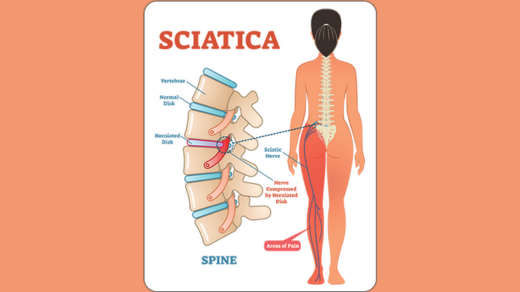
What is Sciatica? Symptoms | Causes | Treatment option
31 nerves in the spinal cord control the sensory and motor functions. The Sciatic nerve is one such long nerve that travels alongside the Spinal cord, enters the buttocks, and ends up in both the thighs. When the herniated spinal disc puts pressure on this nerve, doctors call it Sciatica. In this condition, the individual experiences dull to sharp pain and tingling sensation in the buttocks, Thighs, and even calves.
Sciatica is a common condition and causes severe pain to the individual. Be it the tingling sensation or excruciating pain, it’s important to know if it’s a symptom of sciatica and know more about the causes of the same.
Symptoms of Sciatica
Sciatica is painful, and some of its symptoms are often ignored, considering them common pain. Here are the symptoms that individuals should not ignore.
- Medium or severe pain in the Buttocks, thighs, or calves
- No pain but weakness in the legs
- Pain that progresses after walking or sitting for a long time
- Tingling sensation in the Feet, Toes and Calves
- The sensation of Pins and Needles being pricked in Toes, Feet, and Calves
These symptoms might feel like regular pain, but they must not be ignored when experienced.
What are the Causes of Sciatica?
Here are a few reasons behind the onset of Sciatica.
#1 – Degenerative Disc Disorder
With the increasing age, the spinal discs get herniated due to wear and tear. This can exert pressure on the sciatic nerve and individuals can cause the symptoms.
#2 – Slipped Disc
When the spinal discs slip from the place due to blunt trauma via accidents or falls, they cause sciatica.
#3 – Spondylolisthesis
This is a condition, in which the vertebrae are misaligned from each other and exert the pressure on Sciatic nerve running through these vertebrae.
#4 – Trauma Injury
Trauma is one of the major reasons behind the Sciatica. Any impact on the spine can trigger sciatica pain.
How Do Doctors Diagnose Sciatica?
The doctors perform a lot of tests to accurately diagnose Sciatica in the patients. The first and foremost is the physical examination, and then the actual imaging tests are done to confirm the diagnosis.
#1 – CT Scan
The doctors do the CT Scan to identify the structure of the Discs if they are misaligned or have any injuries. A special dye is injected to get a better image in the scans.
#2 – MRI
Magnetic Resonance Imaging is done to get the cross-section picture of every part and observe the minute details.
#3 – X-Rays
X-rays are commonly used as the first phase of imaging, but that’s not very useful in case of severe sciatica pain.
#4 – EMG
EMG, or Electromyography, is a test for checking the electric pulses from the nerves. This test helps doctors understand the irregularities in the electrical pulses and determine whether the sciatic nerve is compressed.
Sciatica Pain Treatment Options
It’s always better to approach the doctors before the condition worsens. Physiotherapy is a non-surgical option to treat and gain relief from Sciatica pain. In case of severe cases, the surgical intervention might be needed. As ANSSI, holistic non-surgical treatment is provided to treat the Sciatica pain.



